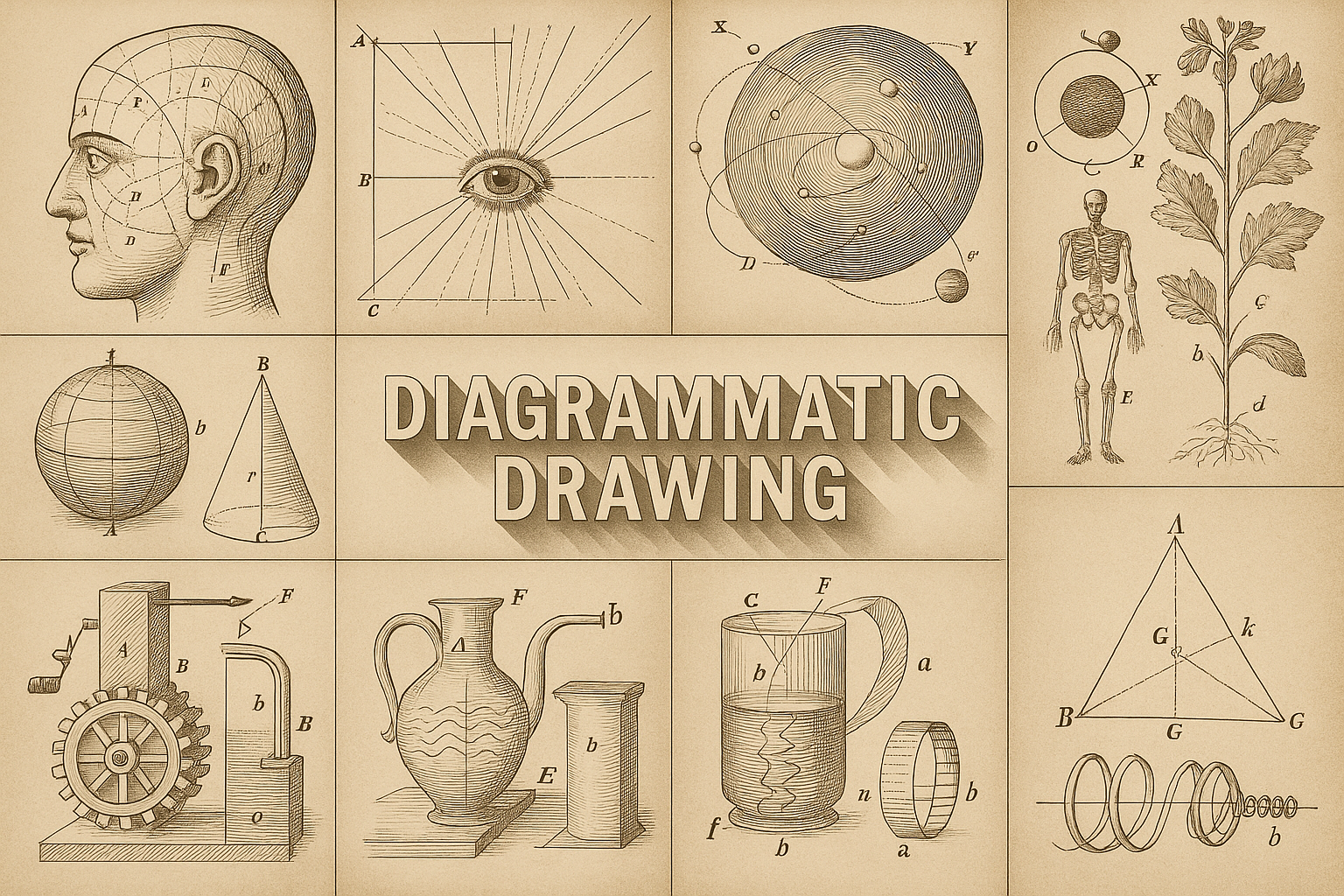
Diagrammatic Drawing
Diagrammatic drawing is a type of drawing that uses simple geometric shapes to represent complex objects or scenes. Diagrammatic drawing is often used to create illustrations or diagrams that explain how something works.
AOI thinking about Diagrammatic Drawing [+_~]-/
Overview and Quickfacts
Diagrammatic drawing is a type of drawing that uses abstract, symbolic shapes to represent different objects, actions, or ideas. This type of drawing is often used in technical illustrations and diagrams.
Can understand it also, as:
Sketch, drawing, chart, illustration
Categorize it as:
Impressionism, Modernism
.: Dreaming :.
holds a HAIKU for the art style
:. Thought is power .:
Detailed Description
Diagrammatic drawing is a type of drawing that uses abstract, simplified shapes to represent objects or concepts. It is often used in technical drawings and diagrams, but can also be used for more creative purposes. Famous artists who have used diagrammatic drawing include Piet Mondrian, who used it to create his famous abstract paintings, and M.C. Escher, who used it to create his intricate drawings and lithographs. Diagrammatic drawing can be a very effective way of communicating ideas and concepts. It can be used to create both realistic and abstract images, and can be adapted to suit a wide range of purposes.
.. beep, beep, beep ..
<START OF TRANSMISSION>
1. Diagrammatic drawing is a type of drawing that uses abstract, symbolic shapes to represent concepts or ideas. 2. Diagrammatic drawing is often used in mathematics and science to convey complex information in a concise and visual way. 3. Diagrammatic drawing is believed to have originated in the early days of human civilization, with early examples found in cave paintings and ancient Egyptian hieroglyphs. 4. The term ÃÂÃÂdiagramÃÂÃÂ comes from the Greek word ÃÂÃÂdiaÃÂÃÂ, meaning ÃÂÃÂthroughÃÂÃÂ, and ÃÂÃÂgrammaÃÂÃÂ, meaning ÃÂÃÂletterÃÂÃÂ or ÃÂÃÂdrawingÃÂÃÂ. 5. The first known use of the term ÃÂÃÂdiagramÃÂÃÂ in English was in 1597, in a work by John Dee. 6. In the 17th and 18th centuries, diagrammatic drawing was used extensively by scientists such as Isaac Newton and Gottfried Leibniz to visualize their ideas. 7. In the 19th century, diagrammatic drawing became increasingly popular in the field of education, with educators using it to teach everything from grammar to geometry. 8. Today, diagrammatic drawing is used in a variety of fields, including architecture, engineering, and medicine. 9. Diagrammatic drawing is often used to create flowcharts, circuit diagrams, and other types of technical drawings. 10. Flowcharts are diagrams that show the steps in a process, and are often used in business and computer programming. 11. Circuit diagrams are diagrams that show the electrical components and connections in a circuit. 12. Technical drawings are drawings that show the detailed specifications of an object or system. 13. Diagrammatic drawing can also be used for more creative purposes, such as creating illustrations and infographics. 14. Illustrations are drawings that are used to explain or clarify a concept. 15. Infographics are visual representations of information or data, often using charts, graphs, and icons. 16. Diagrammatic drawing is a versatile tool that can be used to communicate a wide range of information. 17. Diagrammatic drawing is an effective way to learn and remember information. 18. Diagrammatic drawing can help to make complex information more understandable. 19. Diagrammatic drawing can be used to create both simple and complex diagrams. 20. Diagrammatic drawing is a useful tool for both students and professionals.
<EOF>
.. robbel bob
Visual Examples from our image gallery
Coming soon, we are so slow .. might never come
Artists, Paintings, and more
(be aware, can be highly speculative)
Artists (be aware, speculation possible):
1. Albrecht DÃÂürer (1471-1528) 2. Leonardo da Vinci (1452-1519) 3. Rembrandt (1606-1669) 4. Michelangelo (1475-1564) 5. Raphael (1483-1520) 6. Jan van Eyck (1390-1441) 7. Hieronymus Bosch (1450-1516) 8. Pieter Bruegel the Elder (1525-1569) 9. Lucas Cranach the Elder (1472-1553) 10. Matthias GrÃÂünewald (1470-1528) 11. Andrea Mantegna (1431-1506) 12. Giotto (1267-1337) 13. Masaccio (1401-1428) 14. Fra Angelico (1395-1455) 15. Uccello (1397-1475) 16. Piero della Francesca (1415-1492) 17. Caravaggio (1571-1610) 18. Titian (1488-1576) 19. Tintoretto (1518-1594) 20. Veronese (1528-1588) 21. VelÃÂázquez (1599-1660) 22. Goya (1746-1828) 23. David (1748-1825) 24. Ingres (1780-1867) 25. CÃÂézanne (1839-1906) 26. Gauguin (1848-1903) 27. Van Gogh (1853-1890) 28. Seurat (1859-1891) 29. Toulouse-Lautrec (1864-1901) 30. Picasso (1881-1973)
Artworks (be aware, speculation possible)
1. The Hay Wagon, by American painter Andrew Wyeth (1937) 2. The Persistence of Memory, by Spanish painter Salvador Dali (1931) 3. Nighthawks, by American painter Edward Hopper (1942) 4. American Gothic, by American painter Grant Wood (1930) 5. The Scream, by Norwegian painter Edvard Munch (1893) 6. The Starry Night, by Dutch painter Vincent van Gogh (1889) 7. The Madonna of the Pinks, by Italian painter Raphael (1507) 8. The Sistine Chapel ceiling, by Italian painter Michelangelo (1512) 9. The Birth of Venus, by Italian painter Sandro Botticelli (1486) 10. The Arnolfini Portrait, by Flemish painter Jan van Eyck (1434) 11. The Hay Wagon, by American painter Andrew Wyeth (1937) 12. The Persistence of Memory, by Spanish painter Salvador Dali (1931) 13. Nighthawks, by American painter Edward Hopper (1942) 14. American Gothic, by American painter Grant Wood (1930) 15. The Scream, by Norwegian painter Edvard Munch (1893) 16. The Starry Night, by Dutch painter Vincent van Gogh (1889) 17. The Madonna of the Pinks, by Italian painter Raphael (1507) 18. The Sistine Chapel ceiling, by Italian painter Michelangelo (1512) 19. The Birth of Venus, by Italian painter Sandro Botticelli (1486) 20. The Arnolfini Portrait, by Flemish painter Jan van Eyck (1434) 21. The Hay Wagon, by American painter Andrew Wyeth (1937) 22. The Persistence of Memory, by Spanish painter Salvador Dali (1931) 23. Nighthawks, by American painter Edward Hopper (1942) 24. American Gothic, by American painter Grant Wood (1930) 25. The Scream, by Norwegian painter Edvard Munch (1893) 26. The Starry Night, by Dutch painter Vincent van Gogh (1889) 27. The Madonna of the Pinks, by Italian painter Raphael (1507) 28. The Sistine Chapel ceiling, by Italian painter Michelangelo (1512) 29. The Birth of Venus, by Italian painter Sandro Botticelli (1486) 30. The Arnolfini Portrait, by Flemish painter Jan van Eyck (1434)
Epoch
The time period of the art style Diagrammatic Drawing is the 20th century.
AI ART RESSOURCES (AKA, well Tools)
Helping tools -> predefined search links on other pages:











